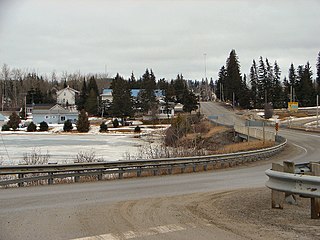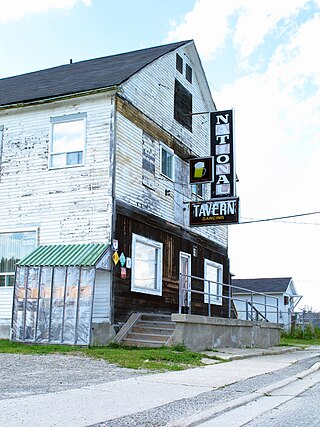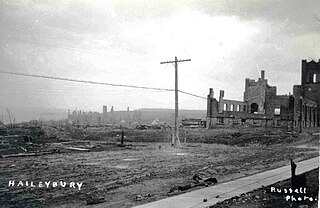
The Ontario Northland Railway is a Canadian railway operated by the Ontario Northland Transportation Commission, a provincial Crown agency of the government of Ontario.

Temiskaming Shores is a city in the Timiskaming District in Northeastern Ontario, Canada. It was created by the amalgamation of the town of New Liskeard, the town of Haileybury, and the township of Dymond in 2004. The city had a total population of 9,634 in the Canada 2021 Census. Temiskaming Shores is Ontario's second-smallest city, in terms of population, after Dryden. Haileybury is the seat of Timiskaming District.

Cochrane is a town in northeastern Ontario, Canada. It is located east of Kapuskasing, northeast of Timmins, south of Moosonee, and north of Iroquois Falls. It is about a one-hour drive from Timmins, the major city of the region. It is the seat of Cochrane District. The town's population is made up of about half anglophone and half francophone residents.

Cobalt is a town in Timiskaming District, Ontario, Canada. It had a population of 1,118 at the 2016 Census. The population is now closer to 943.

Black River-Matheson is a township in the Cochrane District of the Canadian province of Ontario. The municipality is astride the Black River, for which it is partly named. The Matheson railway station was serviced by the Northlander until 2012.

Iroquois Falls is a town in Northern Ontario, Canada, with a population of 4,537 at the 2016 census.
Noah Anthony Timmins was a Canadian mining financier and developer who is now counted among the founding fathers of Canada's mining industry.

Timiskaming—Cochrane is a provincial electoral district in northern Ontario, Canada. It elects one member to the Legislative Assembly of Ontario.
King's Highway 112, commonly referred to as Highway 112, is a provincially maintained highway in the northern portion of the Canadian province of Ontario. Formerly part of the Ferguson Highway, the route was designated with its own number in 1953, prior to which it formed a part of Highway 11. It travels east of the current Highway 11, around Round Lake and through Dane before ending at Highway 66 southwest of Kirkland Lake.

Charlton and Dack is a municipality in the Canadian province of Ontario, located within the Timiskaming District. Its population in 2016 was 686.

Val Gagné is an unincorporated rural community in the township of Black River-Matheson, Cochrane District, Ontario, Canada. It is located 1.5 km (0.93 mi) east of Highway 11, between Matheson and Iroquois Falls. For many years the community was accessible by train. The Ontario Northland Railway's Northlander from Toronto to Cochrane, which passed through Val Gagné, made its final passenger run in 2012. An Ontario Northland bus now stops at Val Gagné.
Highway 11B is the designation for ten business routes of Highway 11 in the Canadian province of Ontario. All but one was the original route of Highway 11 through the town or city that it served, and was subsequently given the 11B designation when a newer bypass route was constructed to reduce traffic pressure on the urban street network. Seven of the nine sections of Highway 11B have now been decommissioned by the Ministry of Transportation, with the exception of the Atikokan route and the southernmost section of the former Tri-Town route between Cobalt and Highway 11.

The Hon. Michael John O'Brien was a railway builder, industrialist and philanthropist. He was named to the Senate of Canada in 1918. He was a founder of the town of Renfrew, Ontario. He was instrumental in the early history of professional ice hockey in Eastern Canada.

The Great Fire of 1922 was a wildfire burning through the Lesser Clay Belt in the Timiskaming District, Ontario, Canada, from October 4 to 5, 1922. It has been called one of the ten worst natural disasters in Canadian history.

Matheson station is located in the township of Black River-Matheson in Ontario, Canada.

The Great Porcupine Fire of 1911 was one of the most devastating forest fires ever to strike the Ontario northland. Spring had come early that year, followed by an abnormally hot dry spell that lasted into the summer. This created ideal conditions for the ensuing disaster, in which a number of smaller fires converged.
The Ferguson Highway was a 260 mi (420 km) long gravel trunk road in Ontario, Canada. Built between 1925 and 1927 from the city of North Bay to the town of Cochrane, it was created to connect the growing agricultural and mining communities of Northern Ontario with other areas further south. The road eventually became part of Highway 11, and was largely bypassed by improved routings in the 1940s and 1950s.

The Black River is a river in Cochrane District and Timiskaming District in Northeastern Ontario, Canada. It is part of the James Bay drainage basin, and is a right tributary of the Abitibi River. The municipality of Black River-Matheson is named after the river.
Henry Timmins was a Canadian shopkeeper who, with his younger brother, Noah, became an influential mining financier. The brothers are considered to be among the most significant founding fathers of the Canadian mining industry.














